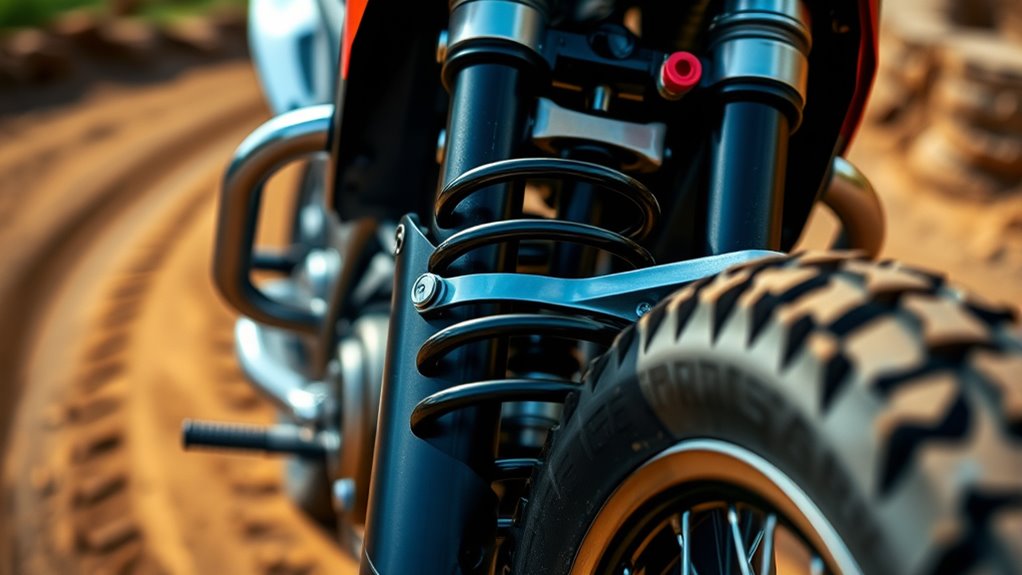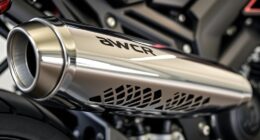To tune your suspension for high-speed stability in whoops, start by adjusting your preload and sag for ideal responsiveness. Fine-tune compression damping to absorb impacts without harshness, and set rebound damping so the suspension recovers smoothly. Make sure your ride height is correct for balanced handling and consider the right spring rates for speed and comfort. Small adjustments make a big difference, and if you want to maximize control, you’ll find that the next steps can further refine your setup.
Key Takeaways
- Adjust preload and sag to optimize suspension response and keep the bike stable over whoops.
- Fine-tune compression damping to absorb impacts smoothly, preventing harsh jolts at high speed.
- Set rebound damping to control suspension recovery, maintaining wheel contact and stability through whoop sections.
- Ensure proper ride height to balance impact absorption and prevent bottoming out during rapid terrain changes.
- Regularly test and refine suspension settings based on rider feedback to enhance high-speed stability and confidence.
Understanding the Role of Suspension in Whoops
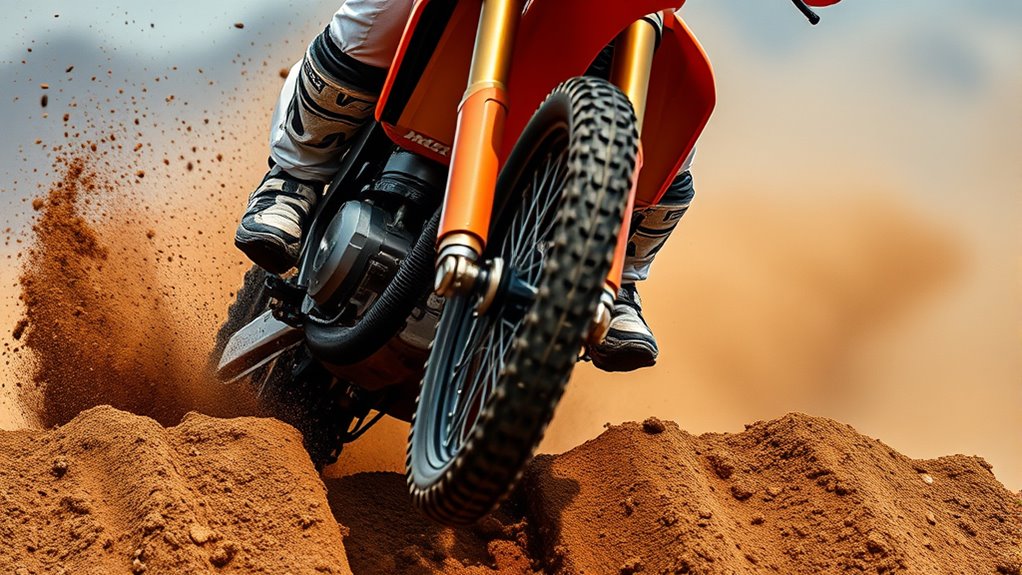
Understanding the role of suspension in whoops is essential for maintaining control and stability at high speeds. Your suspension absorbs the impact of each bump, preventing the chassis from bouncing excessively. When set up correctly, it keeps your wheels in contact with the ground, ensuring traction and smoother handling. Proper suspension also manages the energy from hits, reducing rider fatigue and improving responsiveness. If your suspension is too soft, you’ll feel excessive bouncing, losing control. Too stiff, and you’ll transmit harsh impacts, making steering difficult. Adjusting compression and rebound damping helps fine-tune how quickly the suspension reacts to whoops. High-pressure application in airless paint sprayers demonstrates the importance of proper setup for achieving a smooth finish. Ultimately, a well-balanced suspension setup allows you to navigate whoops confidently, maintain momentum, and stay in control, especially when speeds increase.
Assessing Your Current Suspension Setup

Before making adjustments to your suspension for high-speed whoops, it’s vital to assess your current setup thoroughly. Start by inspecting the suspension components for any signs of wear or damage, such as leaks or bent parts. Check your sag—the suspension’s compression when you’re seated on the bike—and ensure it matches your rider weight and riding style. Test ride on similar terrain and note how the bike responds—does it feel too soft, too stiff, or unstable at speed? Pay attention to any bouncing, bottoming out, or lack of control. Make a mental or written note of these observations. This baseline assessment helps you identify what’s working well and what needs improvement before proceeding with specific tuning adjustments.
Adjusting Compression Damping for High-Speed Stability

Adjusting your compression damping is essential for maintaining high-speed stability over whoops. When compression damping is too stiff, the suspension won’t absorb impacts smoothly, causing your bike to jolt and lose control. Conversely, if it’s too soft, the suspension will bottom out, leading to a harsh ride and reduced stability. To fine-tune this, start by increasing compression damping slightly and test the bike at high speed over whoops. You should notice improved control and a smoother ride. If the bike feels too stiff or begins to skip off the surface, ease the damping back. The goal is to find a balance where the suspension absorbs impacts efficiently without feeling overly firm or soft. Proper compression damping adjustment keeps your front end planted and enhances your confidence at high speed. Additionally, ensuring that your headphones are properly paired and functioning can help you stay focused and aware of your riding environment.
Tuning Rebound Damping to Enhance Control
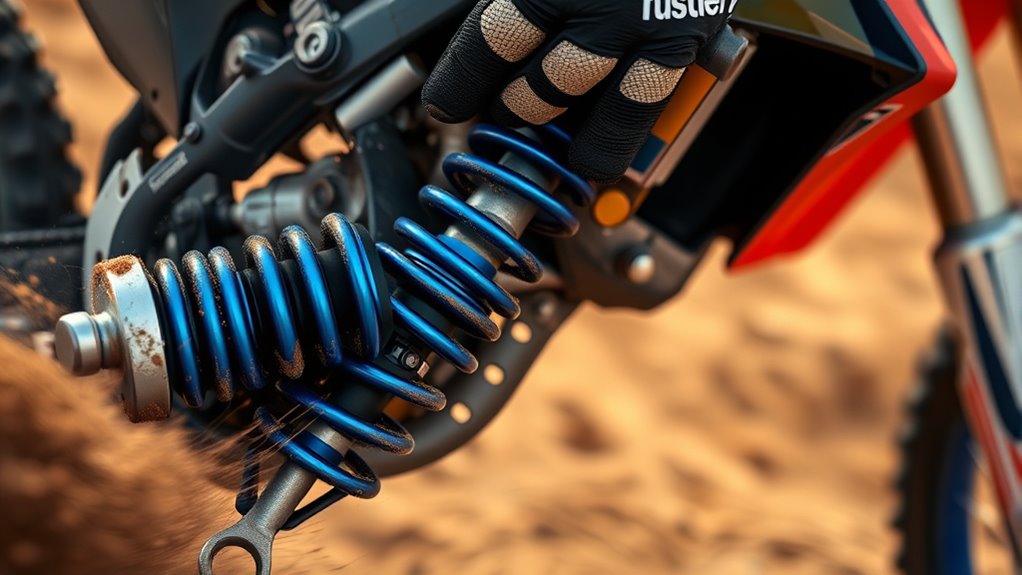
Tuning rebound damping is essential for controlling how quickly your suspension recovers after absorbing impacts, which directly affects your stability over whoops. If rebound is too fast, your suspension kicks back too quickly, causing a choppy ride and reduced control. Too slow, and your suspension lags, leading to a sluggish feel and loss of traction. To find the right setting, start with the manufacturer’s recommendation and make small adjustments. Increase rebound damping for smoother, more controlled recovery, especially at high speeds. This helps your bike stay planted and responsive over successive whoops. Conversely, if your bike feels sluggish, reduce rebound. The goal is a balanced rebound that allows your suspension to recover swiftly without bouncing excessively, giving you maximum control and confidence.
Setting the Correct Ride Height for Whoops
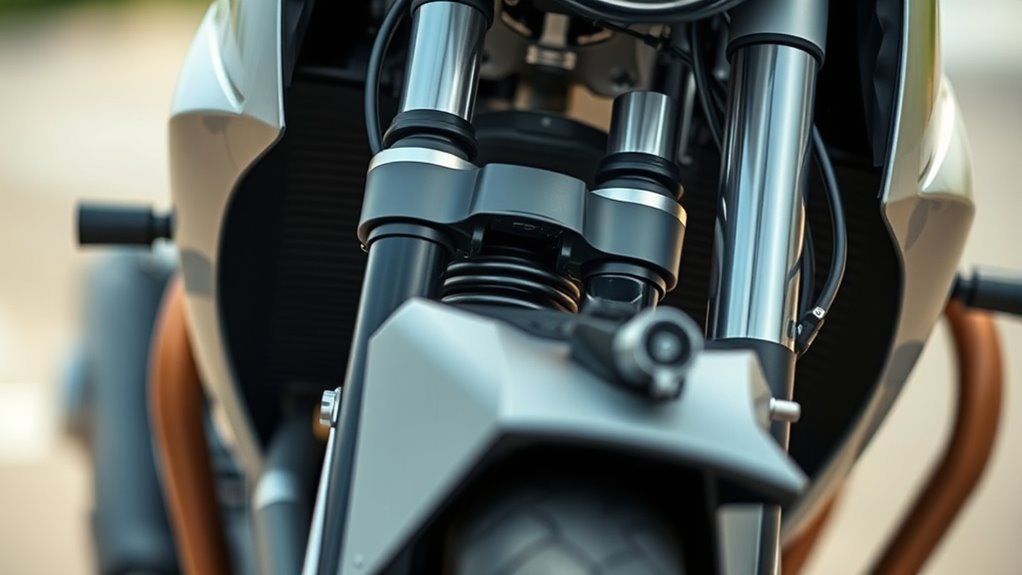
Setting the right ride height is essential for ideal suspension performance in whoops. When you get this right, it directly influences how your bike absorbs bumps and maintains stability at high speed. Focus on how ride height affects suspension dynamics to find the perfect balance for your riding style. Additionally, understanding dynamic contrast ratios can help you optimize your bike’s suspension settings for varying terrain conditions.
Optimal Ride Height Selection
Choosing the right ride height is essential for maintaining high-speed stability through whoops. If your motorcycle sits too high, you’ll lose control and feel excessive front-end hopping. Conversely, if it’s too low, you risk bottoming out and losing suspension travel, negatively impacting handling. To find the ideal ride height, start with manufacturer recommendations and then fine-tune based on your riding style and terrain. Adjust the preload on your forks and shock to slightly lower or raise the bike, then test it on whoops. Look for a balance where the bike remains stable, absorbs bumps smoothly, and maintains consistent contact with the ground. Remember, small adjustments can make a significant difference in delivering the stability needed for high-speed whoops. Incorporating proper suspension setup can further enhance your bike’s handling and stability at high speeds.
Impact on Suspension Dynamics
When you adjust your ride height, you directly influence how your suspension responds to the harsh impacts of whoops. A lower ride height increases suspension compression, making it more responsive but risking bottoming out on rough terrain. Conversely, a higher ride height reduces compression, providing more ground clearance but potentially causing less stability at high speeds. Properly setting your ride height guarantees your suspension absorbs impacts efficiently, maintaining control and reducing rider fatigue. It also affects how quickly your suspension rebounds, influencing overall stability and steering feel. Too low, and you risk harsh jarring; too high, and you may experience sluggish handling. Finding the right balance optimizes suspension dynamics, helping you stay composed and confident through high-speed whoops. Additionally, ride height adjustment plays a crucial role in balancing comfort and performance, especially on uneven terrain.
Selecting the Optimal Spring Rates for Speed and Comfort

Selecting the right spring rates is essential for balancing speed and comfort when tackling whoops at high velocity. Too stiff, and you’ll transmit every bump directly to your arms, causing fatigue and instability. Too soft, and your bike will feel sluggish, absorbing energy and losing control. To find the sweet spot, consider:
Choosing the right spring rates balances speed, comfort, and control over high-velocity whoops.
- Achieving smooth, confident landings that boost your adrenaline
- Maintaining high-speed stability without sacrificing comfort
- Feeling confident to push your limits with controlled, precise handling
- Understanding how narcissistic behaviors can influence your perception of control and confidence on the track
Choosing the correct spring rates enhances your control, minimizes rider fatigue, and keeps you focused on the race ahead. It’s about creating a setup that responds perfectly to your riding style and the demands of high-speed whoops, so you can stay composed and in control through every bump.
Fine-Tuning Sag and Preload for Better Responsiveness
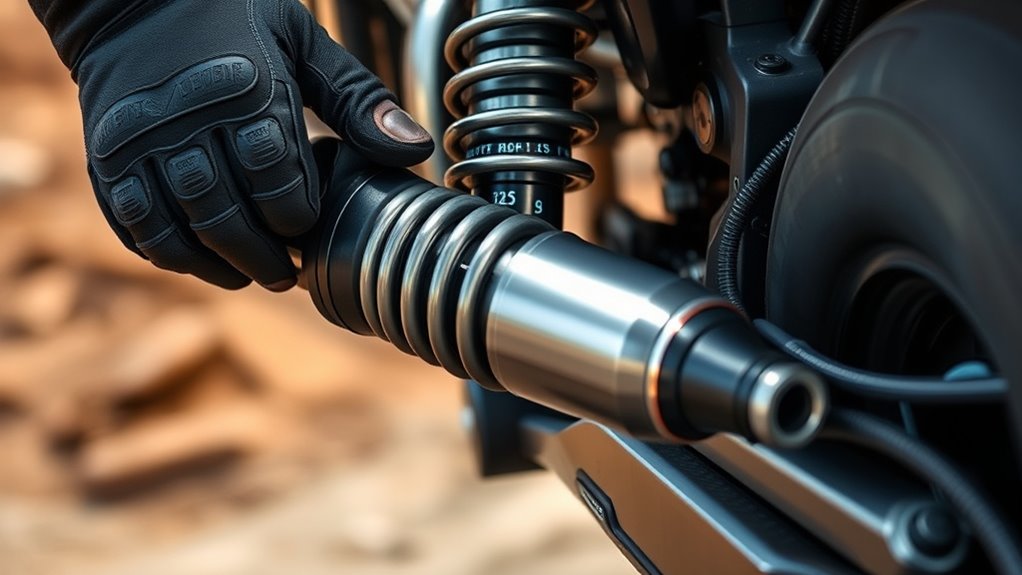
Adjusting your sag helps keep the bike stable without sacrificing responsiveness, especially at high speeds. Preload impacts how your suspension handles different terrains, so fine-tuning it can enhance control. Finding the right balance between responsiveness and comfort ensures you stay confident and in control during those rapid whoop sections. Incorporating exotic fruit blends into your diet can also boost overall energy and recovery on tough rides.
Adjusting Sag for Stability
Fine-tuning sag is essential for achieving high-speed stability in whoops, as it directly influences how your suspension responds to terrain. When you set your sag correctly, your bike maintains better control, absorbs impacts smoothly, and reduces fatigue during long rides. Proper sag allows the suspension to stay active without bottoming out or feeling too stiff, giving you confidence at speed. To optimize your setup, focus on:
- Feeling the thrill of razor-sharp handling with every bump
- Gaining the confidence to power through whoops at higher speeds
- Enjoying a smoother, more controlled ride that keeps you ahead of the pack
Adjusting sag isn’t just about numbers; it’s about creating a responsive, stable feeling that transforms your riding experience. Small changes can make a huge difference in how your bike reacts under high-speed conditions. Effective suspension setup is key to maximizing high-speed stability and overall performance.
Preload Impact on Handling
Preload plays a key role in how your suspension responds to terrain, especially when aiming for high-speed stability in whoops. Increasing preload compresses the spring, making the suspension stiffer and reducing its tendency to bottom out. This firmness helps maintain control at high speeds, preventing excessive suspension movement that can cause instability. Conversely, too much preload can make the ride harsh, reducing traction and comfort. Adjusting preload allows you to fine-tune how your bike reacts to rapid terrain changes. You want enough preload to keep the suspension firm enough to handle the bumps without sacrificing too much comfort or responsiveness. Proper preload setup ensures your suspension stays composed during fast whoops, giving you better handling and confidence on rough, high-speed sections. Additionally, understanding suspension tuning can help you optimize your setup for specific riding conditions.
Balancing Responsiveness and Comfort
To achieve ideal high-speed stability in whoops, you need to balance your suspension’s responsiveness with rider comfort by fine-tuning sag and preload. Proper adjustment guarantees your bike reacts quickly without sacrificing control or causing fatigue. When you set sag correctly, you’ll experience:
- A smoother ride that absorbs bumps effortlessly
- Better feedback, so you feel connected to the terrain
- Reduced rider fatigue, maintaining focus and confidence
Adjusting suspension settings carefully to match your weight and riding style, optimizing how your suspension responds at high speeds. Too much preload can make the ride harsh, while too little can cause sluggishness. Striking the right balance enhances both stability and comfort, giving you the confidence to tackle whoops with precision.
Inspecting and Maintaining Suspension Components
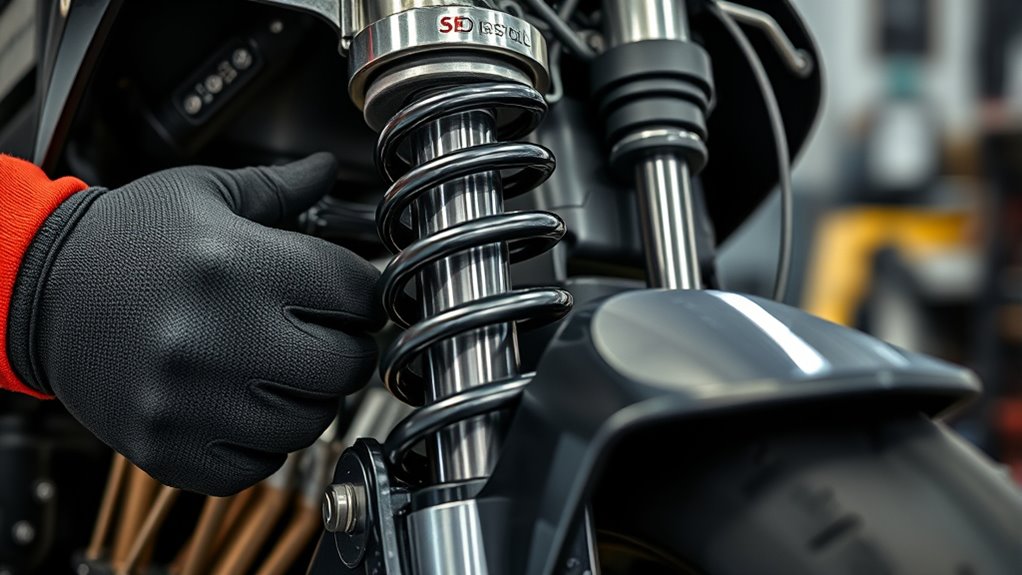
Regularly inspecting and maintaining your suspension components is essential to guarantee your bike stays stable and responsive during high-speed runs through whoops. Check for leaks, wear, and damage on forks, shocks, and bushings. Clean components to prevent dirt buildup that can cause premature wear. Adjust or replace parts as needed to ensure proper function. Proper maintenance can prevent sudden failures and improve handling. Here’s a quick reminder of key inspection points:
| Component | What to Check | Recommended Action |
|---|---|---|
| Forks | Leaks, smooth movement | Service or replace seals |
| Shock | Damping, leaks | Rebuild or replace if needed |
| Bushings | Excess play | Lubricate or replace |
| Springs | Sag, fatigue | Replace or adjust tension |
Testing and Refining Your Suspension Settings on the Track

Testing and refining your suspension settings on the track is essential to achieving ideal high-speed stability through whoops. You need to feel the bike respond instantly and confidently at speed. Focus on these key aspects during your test rides:
- Adjust your rebound and compression to balance control and comfort
- Listen for any harsh impacts or excessive bouncing
- Note your confidence level and bike behavior through each section
Push yourself to small, controlled limits, then tweak settings based on your feedback. Consistent testing lets you fine-tune suspension for maximum stability. Remember, even minor adjustments can drastically improve your control and confidence when ripping through whoops at high speed. Patience and precise changes are your best tools for mastering the perfect setup.
Frequently Asked Questions
How Do Environmental Conditions Affect Suspension Tuning for Whoops?
Environmental conditions greatly impact your suspension tuning for whoops. Mud, sand, or loose gravel can cause your bike to lose traction, so you might need to soften your suspension for better absorption. Conversely, on hard-packed or rocky surfaces, stiffening your suspension helps maintain stability at high speeds. Always assess the track conditions before riding, and adjust your suspension accordingly to optimize performance and safety through different environmental challenges.
What Aftermarket Suspension Components Can Improve High-Speed Whoops Performance?
Imagine your bike as a swift bird soaring through rugged skies. To enhance high-speed whoops performance, you can upgrade to aftermarket components like stiffer shocks, adjustable coilovers, and reinforced control arms. These parts act as the bird’s strong wings and steady feathers, giving you better stability, control, and confidence at high speeds. With these upgrades, you’ll feel more in tune with the terrain, conquering whoops like a true flying predator.
How Often Should Suspension Be Re-Tuned After Initial Setup?
You should re-tune your suspension whenever you notice handling issues, increased vibrations, or after significant riding changes. Regular checks, especially after hitting tough whoops or rough terrain, help maintain peak performance. Typically, every few rides or at least once a season, reassess your settings. Staying attentive to your bike’s behavior ensures you keep high-speed stability and comfort, preventing premature wear and improving overall ride quality.
Can Rider Weight Influence Suspension Adjustments for Whoops?
Your rider weight definitely influences suspension adjustments for whoops. Heavier riders need stiffer settings to prevent bottoming out and maintain stability at high speeds. Conversely, lighter riders benefit from softer settings for better control and comfort. You should tailor your suspension to your weight, ensuring the damping and spring rates are appropriate. Regularly check and adjust your setup as your weight or riding style changes to keep your bike tuned for whoops.
Are There Specific Suspension Settings for Different Types of Whoops Terrain?
While every whoops section is unique, you should adjust your suspension settings based on the terrain type. For tight, chattery whoops, soften your suspension to absorb bumps smoothly. For fast, flowing whoops, stiffen it for stability. You’ll want to experiment with compression and rebound settings, balancing comfort and control. Tailoring your suspension to each terrain type helps you maintain speed and control, making your ride more confident and enjoyable.
Conclusion
Tuning your suspension for high-speed stability in whoops is like mastering a dance—each adjustment brings you closer to perfect harmony. With patience and careful tweaks, you’ll feel more in control and confident on the track. Remember, small changes can make a big difference, so stay attentive and keep testing. When your suspension sings smoothly over whoops, it’s as exhilarating as riding a wave—thrilling and freeing.
